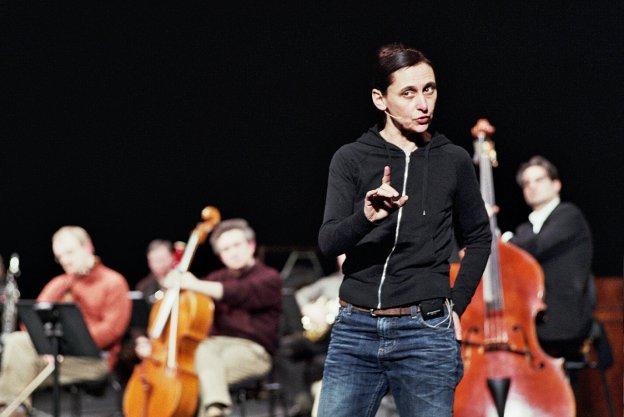It is rare to see a work that has an audience rushing for the exit in the first curtain call, a veritable snub, in full and uncontested view, to the artists, but3Abschied (3Farewells) appears to be such a work. This collaboration between the deeply structural Anne Teresa de Keersmaeker and French post-structuralist dancer Jérôme Bel is both a product of them and not of them. It is Bel though whose eyes you need to see this work through.
Set to Mahler’s ‘undanceable’ score for the final part of his ‘Song of the Earth’,3Abschied is a dance that attempts to grapple with the repercussions of looming (planetary) extinction. It is also, as with much of Bel’s previous work, a provocation of the nature of dance. For de Keersmaeker 3Abschied is a personal work operating in her own emotional territory, and unlike many of her previous works it wears its politics overtly.
Bel’s insouciant trademark stamp comes in the form of an opening lecture on the process of making the work, delivered casually by de Keersmaeker and preceded by a CD recording of the ‘Abschied’. She directly questions the validity of her attempt, exposing the journey to – and processes that underlie – the dance; and the recognition of the political act that they have set out to stage. Bel appears explicitly only at the termination of the piece, introducing multiple unsatisfactory endings – equally toying with the supposed impossibility of their task.
In the dance itself de Keersmaeker unfurls her expressionist roots as she attempts to inhabit the music, played onstage by the Ictus ensemble. Cast adrift from the formal structures of the music of previous choreographies de Keersmaeker has the quality of a dancer who has lost her way. Clumsy and unbalanced she fails in her attempted ideas of dancing to the score amongst and around the musicians. The vocabulary is sparse and clearly taken from the actions of the musicians. de Keersmaeker appears to drown amongst the music, lost in the eddies and currents of the orchestral phrases, as she attempts to evoke the crisis and final acceptance of her own death. But unlike in Mahler’s world, where nature’s immortality, the world’s immortality, is a given; here it is cast off and de Keersmaeker’s crisis is a wider crisis. Like the looming darkness of the upstage area – beyond death is only emptiness.
Adrift of the Romanticist’s cosseting construction, the work flounders in its own pointlessness. It is pointless to dance, but dance de Keersmaeker does. Like a young choreographer finding her first steps or an old one taking her last. The choices are crude, the options underdeveloped – as if collective paralysis had invaded the studio. Only the music lifts and carries – the life in the auditorium – like the bass notes of Jerome Bel’s possible endings. In this way Mahler’s music is left to dominate, trammelling attempts at physical expression. We hear the music three times, as if the point of the dance is for us to experience the music – to sit and listen, rather than to sit and watch, to share the abject state that de Keersmaeker finds herself in – facing death, accepting death. Facing the pointlessness of dance and accepting it – with only Mahler’s music for consolation.
But the kernel of the work is a hard one to grasp, hard to hold onto, and although Bel’s presence brings an archness to this loss, perhaps even an irony, it is never quite clear what failure is constructed and what might be bad choices. Although there is a nagging dissatisfaction with the performance, there is an equal elation in the possible connivances of Bel and de Keersmaeker.


